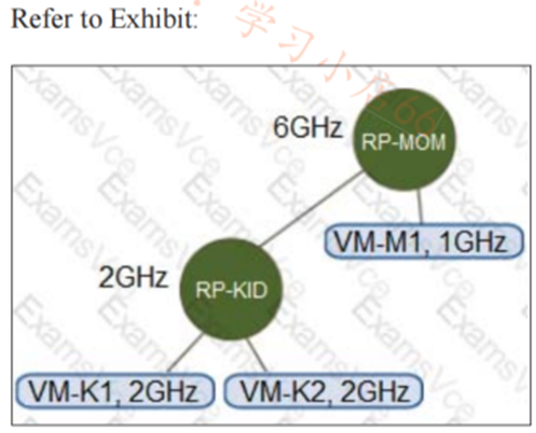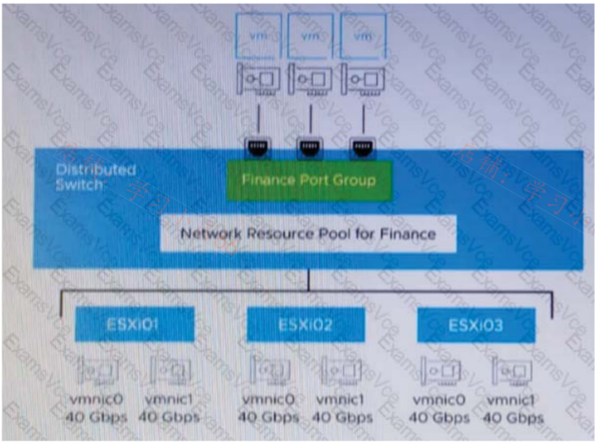

A、 vCenter Management Interface (VAMI)
B、 Perfmon
C、 Df
D、 Esxtop
E、 vSphere Client
F、
G、
H、
I、
J、
答案:AC
解析:



A、 vCenter Management Interface (VAMI)
B、 Perfmon
C、 Df
D、 Esxtop
E、 vSphere Client
F、
G、
H、
I、
J、
答案:AC
解析:



A. Assign a custom memory share value to the resource pool containing the Production VMs.
B. Assign a memory reservation value to the resource pool containing the Production VMs.
C. Create a parent resource pool for the Production VMs
D. Create a sibling resource pool for each of the Production and Test VMs.
E. Create a child resource pool for the Test VMs.
F.
G.
H.
I.
J.
解析:
 An environment has the following configuration: •Resource Pool “RP-MOM? has a reservation of 6GHz and one running virtual machine (VM) ”VM-M1? With 1 GHz reserved •Resource Pool ^RP-KID? has a reservation of 2GHz, and expandable reservations is activated The administrator creates two VMs, “VM-K1? and 'VM-K2?, in the ''RP-KID? resource pool with 2GHz reserved for each, and turns on “VM-M1 ?
An environment has the following configuration: •Resource Pool “RP-MOM? has a reservation of 6GHz and one running virtual machine (VM) ”VM-M1? With 1 GHz reserved •Resource Pool ^RP-KID? has a reservation of 2GHz, and expandable reservations is activated The administrator creates two VMs, “VM-K1? and 'VM-K2?, in the ''RP-KID? resource pool with 2GHz reserved for each, and turns on “VM-M1 ?
A. The administrator must deactivate expandable reservations to turn on VM-K2
B. The administrator can create a third VM ( VM-K3?) at RP-KID and reserve 6GHz
C. VM-K2 can be powered on because it can get the resources needed from RP-MOM
D. VM-K2 cannot be powered on because there are not enough resources in RP-KID.
E.
F.
G.
H.
I.
J.
解析:
A. VMware Horizon
B. VMware vSAN
C. VMware vSphere
D. VMware
解析:解析:Option C is correct because VMware vSphere is the solution that provides a software-defined data center platform that can consolidate physical servers by migrating the workloads to virtual machines. Option A is incorrect because VMware Horizon is a solution for virtual desktop infrastructure (VDI) and application delivery. Option B is incorrect because VMware vSAN is a solution for software-defined storage that is integrated with vSphere. Option D is incorrect because VMware NSX is a solution for software-defined Networking that is integrated with vSphere.选项C是正确的,因为VMware vSphere是提供软件定义的数据中心平台的解决方案,该平台可以通过将工作负载迁移到虚拟机来整合物理服务器。选项A不正确,因为VMware Horizon是虚拟桌面基础架构(VDI)和应用交付的解决方案。选项B不正确,因为VMware vSAN是一种与vSphere集成的软件定义的存储解决方案。选项D不正确,VMware NSX是一种与vSphere集成的软件定义网络解决方案。
A. Storage Policy Based Management
B. Storage I/O Control
C. vSphere Storage APIs for Storage Awareness (VASA)
D. vSphere Distributed Resource Scheduler (DRS)
A. Configure SSO to use Active Directory over LDAP as the identity source.
B. Configure SSO to use OpenLDAP as the identity source.
C. Join the vCenter Server Appliance to the LDAP domain.
D. Configure SSO to use Active Directory (Integrated Windows Authentication) as the identity source.
E.
F.
G.
H.
I.
J.
解析:解析:Integrated Windows Authentication is now depreciated (from v7). ”The Active Directory over LDAP identity source is preferred over the Active Directory (Integrated Windows Authentication) option.”集成的Windows身份验证现在已经过时(从v7开始)。” LDAP身份源上的Active Directory优先于Active Directory(集成Windows身份验证)选项。
A. Create a DNS CNAME record for the vCenter Server (vcsaOl corp.local)
B. Create a DNS CNAME record for the ESXi Host server (esx01 corp.local).
C. Create a reverse DNS A record for the vCenter Server (vcsa0l).
D. Create a reverse DNS A record for the ESXi Host server (esx01 )
E. Create a forward DNS A record for the vCenter Server (vcsa0l ).
F.
G.
H.
I.
J.
解析:解析:The administrator must create a forward DNS A record for the vCenter Server (vcsa01), which maps the FQDN of the vCenter Server to its IP address. The administrator must also create a reverse DNS A record for the ESXi Host server (esx01), which maps the IP address of the ESXi Host to its FQDN. These DNS records are required for name resolution and certificate validation during the deployment of the vCenter Server Appliance.
A. 30000
B. 20000
C. 10
D. 5000
E.
F.
G.
H.
I.
J.
解析:解析: The bronze tier VM is entitled to 30,000 IOPS, which is the maximum number of IOPS that the datastore supports. Storage I/O Control (SIOC) does not limit the IOPS of any VM unless the datastore latency exceeds the threshold, which is 30 ms in this case. Therefore, as long as the datastore latency is below 29 ms, the bronze tier VM can use up to 30,000 IOPS.解释青铜级虚拟机有权获得30,000 IOPS,这是数据存储区支持的最大IOPS数量。存储I/O控制(SIOC)不会限制任何虚拟机的IOPS,除非数据存储延迟超过阈值,在本例中为30毫秒。因此,只要数据存储延迟低于29毫秒,青铜级虚拟机就可以使用多达30,000 IOPS。
 An administrator set up the following configuration: • The distributed switch has three ESXi hosts, and each host has two 40 Gbps NICs.• The amount of bandwidth reserved for virtual machine (VM) traffic is 6 Gbps.The administrator wants to guarantee that VMs in the Finance distributed port group can access 50 percent of the available reserved bandwidth for VM traffic. k Given this scenario, what should the size (in Gbps) of the Finance network resource pool be?
An administrator set up the following configuration: • The distributed switch has three ESXi hosts, and each host has two 40 Gbps NICs.• The amount of bandwidth reserved for virtual machine (VM) traffic is 6 Gbps.The administrator wants to guarantee that VMs in the Finance distributed port group can access 50 percent of the available reserved bandwidth for VM traffic. k Given this scenario, what should the size (in Gbps) of the Finance network resource pool be?
A. 18
B. 80
C. 36
D. 120
E.
F.
G.
H.
I.
J.
解析:解析:The size of the Finance network resource pool should be 50 percent of the reserved bandwidth for VM traffic, which is 6 Gbps x 3 hosts = 18 Gbps.财务网络资源池的大小应为虚拟机流量预留带宽的50%,即6 Gbps x 3台主机= 18 Gbps。
A. Export host customizations and import them to the other host profiles.
B. Copy the storage settings from Standard-Config to all other host profiles.
C. Duplicate the Standard-Config host profile and only modify the storage configuration settings.
D. Export the Standard-Config host profile and attach it to the other hosts.
解析:解析: Option B is correct because it allows the administrator to copy the storage settings from Standard-Config host profile to all other host profiles without affecting other settings. Option A is incorrect because it only exports host customizations and not host profile settings. Option C is incorrect because it creates a new host profile instead of modifying the existing ones. Option D is incorrect because it attaches the Standard-Config host profile to the other hosts instead of changing their host profiles.选项B是正确的,因为它允许管理员将存储设置从标准配置主机配置文件复制到所有其他主机配置文件,而不会影响其他设置。选项A不正确,因为它仅导出主机自定义设置,而不导出主机配置文件设置。选项C不正确,因为它创建了一个新的主机配置文件,而不是修改现有的配置文件。选项D不正确,因为它将标准配置主机配置文件附加到其他主机,而不是更改它们的主机配置文件。
A. VMware vCenter
B. Standalone Velero and Restic
C. NSX-T Manager
D. vSphere Host Client
E. Velero Plugin for vSphere
F.
G.
H.
I.
J.
解析: